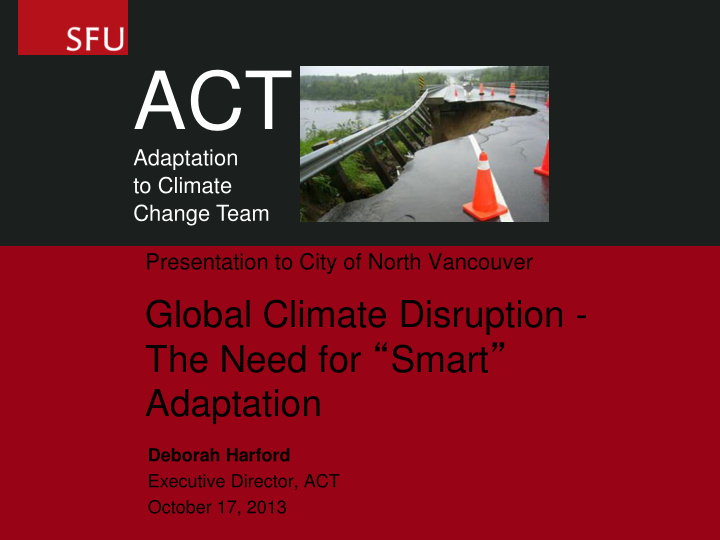



ACT Adaptation to Climate Change Team Presentation to City of North Vancouver Global Climate Disruption - The Need for � Smart � Adaptation Deborah Harford Executive Director, ACT October 17, 2013
The Need for Adaptation AND Mitigation
The Need for Adaptation Planning � Carbon dioxide emissions will continue to contribute to warming and sea level rise for more than a millennium, due to the time scales required for removal of this gas. � ~ The Fourth Assessment Report of the Intergovernmental Panel on Climate Change (IPCC 2007) � Smart � adaptation proposes that we prepare for the short and long term effects of climate change while we work to reduce emissions (mitigation) .
“ Smart ” Adaptation Adaptation is intended to reduce vulnerability and enhance resilience, defined as follows by the IPCC: “ The ability of a social or ecological system to absorb disturbances while retaining the same basic structure and ways of functioning, the capacity for self-organization, and the capacity to adapt to stress and change . ” It is important to couple efforts to mitigate the cause of the problem with efforts to adapt to the current and anticipated effects of climate change. (Save time, money… Lives?!)
Conclusion Adaptation planning can protect communities, resource sectors, and critical infrastructure. It will save time & money if we consider adaptation and mitigation as one issue/ seek win-win solutions.
Aspects of � Vulnerability � The extent of damage from climate change depends to a great extent on vulnerability: Exposure • E.g. geography/energy infrastructure Sensitivity • E.g. vulnerable population groups/continuity of systems Adaptive capacity • Information • Expertise and networks • Fiscal capacity • Political support
Climate Change Threats and Impacts Extreme weather (increased severity and frequency of heat waves, wildfires, rainfall, ice and windstorms, hurricanes, tornados, flooding): impacts infrastructure; transportation; human health. Water shortages (both ongoing and during extended droughts): Impact agricultural sector, energy sector, tourism sector, human settlements, ecosystems. Changes in the cryosphere (permafrost, sea ice, lake ice, snow): Impact northern livelihoods/human settlements/infrastructure; mental health; natural resource extraction based-industry and communities; road and marine transportation routes; ecosystems. Disease, pest and invasive species migration: Impacts human health; economic base in resource- dependent communities (fisheries, forestry, agriculture). Coastal and shoreline erosion due to sea level rise, storm surges and increased storminess: Impacts human settlements; fisheries; health; water supplies. Climate refugees? Already arriving…/Arab Spring?
Observed Impacts: Sea Level Rise Maldives Oct 17, 2009: The President of the Maldives, an island chain that at its highest point is only 8 feet above sea level, conducts an underwater cabinet meeting to sign a document demanding action at Copenhagen. Models project that the Maldives will be submerged by climate change- driven sea level rise within 100 years. Photo source: New York Times and AP Photo/Mohammed Seeneen
Observed Impacts: Canada/World 2013 Calgary Toronto Colorado Russia
Flood Infrastructure Adaptation Spend $1 now and save $5 later…. Think in terms of beauty and ROI! E.g.: Copenhagen ’ s award-winning 2013 Adaptation Plan: Roads become rivers; parks become lakes.
Observed Impacts: Swiss Glacier Glaciers: 70% of fresh water GW 30%; SW 0.9% Himalayas: 1.3BN Andes: 77M Canada: Columbia River relies on runoff Responses: Conserve water Improve storage Ag innovation Ecosystem health The Morteratsch Glacier (2013) has receded 1.6 km since 1950
Observed Impacts: African Drought Drought in Kenya in 2009 killed crops and livestock, leaving 3.8 million people without food. 2013 saw the fifth Africa Drought Adaptation Forum, which featured plans at the community, industry and individual levels to build resilience.
Observed Impacts: South American Coffee 70 percent of coffee producers are smallholder farmers growing on 10 hectares or less. Coffee is especially sensitive to fluctuations in temperature and rainfall. Shade trees can buffer crops from climate extremes such as heavy winds, rainfall, and temperature increases while sequestering carbon.
Adaptation Strategies: Examples National Nigeria: Building Nigeria's Response to Climate Change Project Australia: Climate Adaptation Flagship UK: UKCIP Regional BC: CBT CACCI Netherlands: Flooding Defense Act Australia: Murray-Darling Basin Council Municipal City of Vancouver: Adaptation Plan New York: New York City Panel on Climate Change Jakarta: Great Sea Wall Sectoral U.S. Department of Agriculture: USDA Climate Change Adaptation Plan Engineers Canada: Public Infrastructure Engineering Vulnerability Committee Munich Re: Building alliances around climate insurance
ACT Adaptation to Climate Change Team For more information about ACT, our policy reports, and adaptation resources, please go to: www.sfu.ca/act ACT thanks past and present partners : Zurich Financial Services, Wilburforce Foundation, Bullitt Foundation, BC Ministry of Environment, AMEC Earth & Environmental, BC Hydro, Plutonic Power, INAC, Environment Canada, Real Estate Foundation of BC.
Recommend
More recommend